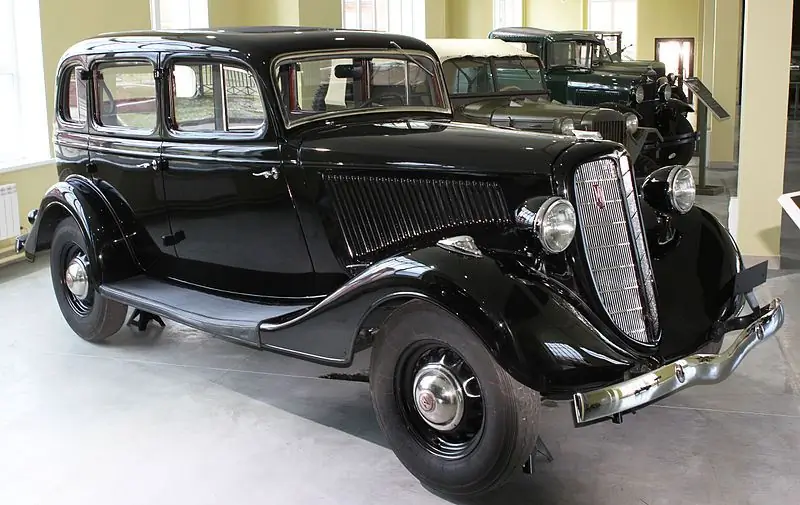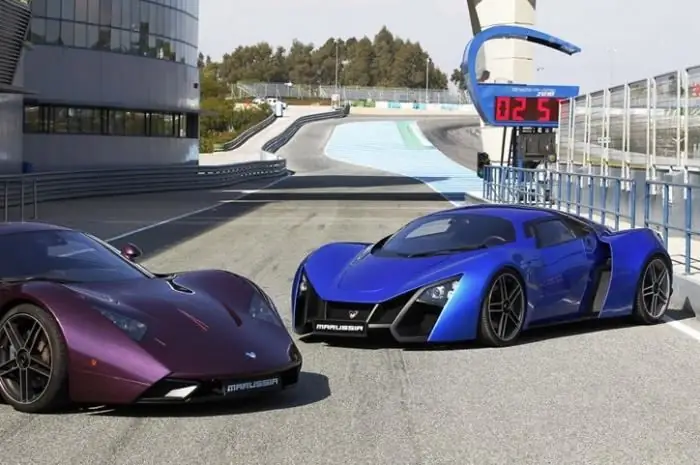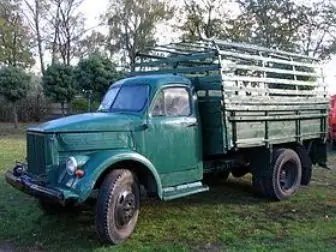2025 Author: Erin Ralphs | [email protected]. Last modified: 2025-06-01 05:35:55
The unique and one of a kind car GAZ-51 is a truck, the production of which became the most massive in the Soviet Union from the 40s to the 70s of the last century. Due to its versatility and load capacity (2500 kilograms), the machine has become widespread in various sectors of the national economy and auxiliary areas. During serial production, almost 3.5 million copies were produced. The production of this equipment was also established in China, Poland, and Korea. Let's take a closer look at the characteristics and features of this legendary truck.

Development
The GAZ-51 car could have been put into mass production already in 1941, but this was prevented by the outbreak of war. Preparations for the phased creation of new items began back in 1937. The main work on the design, development and testing of the vehicle was completed. The relevant authorities issued official permission to launch the program. A prototype was presented at an agricultural exhibition in Moscow(1940).
The design of the truck in question in the last years of the war underwent a large-scale modernization. A team of engineers led by A. Prosvirin tried to take into account all previous shortcomings, as well as to implement the experience gained during the operation of various equipment during the war period, including the features of machines supplied under the contract from America. As a result, the improvement affected the power unit and service units, the car was equipped with a hydraulic brake unit, the appearance and equipment of the cab were modified. In addition, major improvements were introduced in auxiliary systems
Description
The size of the wheels of the GAZ-51 car, the photo of which is presented above, decided to increase, the load capacity was increased to 2.5 tons. We also carried out work on the maximum combination of the truck with the future army counterpart under the index 63.
The first batch of 20 units came out in 1945. A year later, the resurgent national economy received over three thousand trucks of this brand. As tests showed, the car surpassed its predecessors in all respects, including the three-ton ZIS-5, not to mention the "one and a half".
At that time, the GAZ-51 was distinguished by speed (up to 75 km/h), reliability, efficiency, endurance and convenient control. In addition, the car received a softer suspension with efficient shock absorbers and lower fuel consumption.

Serial production
In 1947, they conducted a control run of a truck. The route ran fromGorky to Moscow, Belarus, Ukraine, Moldova and back. The test distance was more than 5.5 thousand kilometers. The car showed itself from the best side.
The production of GAZ-51 cars was constantly increasing, in 1958 a record number of copies of this equipment was produced (173 thousand units). Serial production was launched in Poland (Lublin-51 model), North Korea (Syngri-58), China (Yuejin-130). The last model of this truck was produced at the Gorky Combine in April 1975 and became a museum exhibit.
GAZ-51: specifications
Certain technical innovations introduced into the design of the truck were subsequently used on other types of Soviet and foreign equipment. Among them:
- Presence of wear-resistant cylinder liners made of special cast iron.
- Chrome-plated piston rings.
- Vertical radiator shutters.
- Preheater powered by a blowtorch. The element was a unit in which the coolant was heated in a special boiler, after which the coolant circulated according to the thermosiphon principle, giving off heat to the cylinders and combustion chambers.
- Oil cooler that increases the durability of the power unit.
- Thin-wall bimetal crankshaft liners.
Also, the GAZ-51 car gave world production an aluminum block head, plug-in valve seats, adjustable heating of the mixture, a double method of oil filtration, closed ventilationcrankcase. Lubrication was supplied to the rubbing elements after rough cleaning. Other innovations included easily removable brake drums, which at that time was a real progress.
Dimensions
Below are the main dimensions of the GAZ-51:
- Length/width/height - 5, 71/2, 28/2, 13 m.
- Road clearance - 24.5 cm.
- Wheel base - 3.3 m.
- Track front/rear - 1, 58/1, 65 m.
- Full/curb weight - 5, 15/2, 71 t.
- Tires - 7, 5/20.
Engine GAZ-51
The power plant of the truck in question is a modernized version of the GAZ-11 gasoline engine, which was manufactured by the craftsmen of the Gorky Combine back in 1930. The basis for the engine was the American analogue of the in-line unit with a lower location, known as the Dodge D-5.

Main motor parameters:
- Type - four-stroke six-cylinder carbureted engine.
- Working volume - 3485 cubic centimeters.
- Horsepower is 70.
- RPM - 2750 rotations per minute.
- Torque - 200 Nm.
- Number of valves - 12.
- Compression - 6, 2.
- Average fuel consumption is about 25 liters per 100 km.
Despite the relatively low power, the power unit of the GAZ-51 has excellent traction. It was possible to start it even with a faulty starter and without a battery, using a manual analogue (and almost at anyweather).
Features
It is worth noting that the engine of this truck did not have a decent margin of safety, especially when working with high operational loads at high speeds. Often the "engine" broke down due to the smelting of babbitt from the root bimetallic thin-walled liners of the crankshaft.
During long-term operation at high speeds, the oil supply was not enough, which, together with the absence of overdrive and the presence of the main pair of the rear axle of a special configuration, led to the twisting of the low-speed motor. At this point, a large gear ratio between these elements also negatively affected. In this regard, in order to maintain a sufficient working resource of the motor, the carburetor was equipped with a speed limiter. As a result, the speed of the car under any conditions did not exceed 75 km/h.

Running parameters
The Soviet truck GAZ-51 had a layout with a forward-shifted engine and cab. This solution made it possible to obtain a rather long cargo base with a short base. In principle, the design was typical for most bonnet trucks of that time.
The vehicle is equipped with a single-disk dry clutch transmission, a four-speed gearbox with a single-stage main speed, synchronizers are not provided.
Truck suspension - dependent type with a modern configuration. The design of the unit includes four longitudinal semi-elliptical springs, two spring sprung on the rear axle. Similar mechanismstill used on the current GAZon Next model.
Innovative introduction can be called the presence of hydraulic shock absorbers in the front suspension with levers with paired action. The rigid front axle with a weighted kingpin improves the stability and handling of the machine.
The cargo platform of the GAZ-51 model is made of wood. If necessary, a folding tailgate was used as a continuation of the floor. The structure was fastened with chains that held the side part in a horizontal position. The internal dimensions of the body of this car are 2.94/1, 99/0.54 m. It is permissible to adjust the height by means of extension boards. Since 1955, the truck has been equipped with an updated platform with three folding parts.
Cab
The driver's workplace is equipped as ascetically and simply as possible, nevertheless it is more comfortable and more ergonomic than the analogues of the Soviet "one and a half". On the dashboard there is a necessary set of instruments that are typical for equipping modern vehicles. Watches appeared in the interiors of cars of later releases. The windshield rises forward and up, which in hot weather allows you to get an oncoming flow of fresh air. An interesting detail is the manual windshield wiper drive (as an addition in case of unforeseen situations). The main mode of operation of the wipers is a vacuum drive from a vacuum in the intake manifold.

Since there was a shortage of metal at that time, until the 50th year, the cab of the GAZ-51 car was made of woodenelements and tarps. Later, this part became all-metal and heated. The design of the front part is distinguished by a narrow front hood.
Modifications
During the manufacture of the machine in question, many serial and experimental versions have been developed. Among them (in brackets - the years of issue):
- Series 51H - military variation with a lattice body from the 63rd model. It was equipped with a fuel tank (1948-1975).
- 51U - Temperate export variant (1949-1955).
- NU - military GAZ-51, exported (1949-1975).
- 51B - modification on gas fuel (1949-1960).
- GAZ-41 - a prototype, partly on a caterpillar year (1950).
- F - LPG car (1954-1959).
- ZHU is an analogue of the previous version for export to countries with a temperate climate.
- 51A - An improved version of the basic vehicle with an extended platform, folding side walls, an updated brake system (1955-1975).
- F - an experimental batch with a motor for 80 "horses" (1955).
- 51 AU - export modification for a temperate climate.
- Yu - analogue for tropical climate.
- 51С - version equipped with an additional 105 liter gas tank (1956-1975).
- GAZ-51R is a cargo-passenger model with folding benches, an additional door and a ladder.
- T - cargo taxi (1956-1975).
In addition, the characteristics of GAZ-51 made it possible to produce a number of truck tractors and dump trucks under various indices for the domestic and export markets. Between themselvesthey differed in load capacity, platform dimensions, chassis type and tires.

Interesting facts
On the basis of the truck in question, a line of small category bonneted buses was also released. Vehicles were produced at the Gorky Automobile Plant, Kurgan and Pavlovsk Bus Plants. Modifications of these colorful cars, including open-top versions and ambulance vans, were made throughout the Soviet Union.
In the republics of a vast country, enterprises of various sizes and directions have adapted the GAZ-51 for transformation into specialized equipment (furniture, isothermal booths, aerial platforms, tanks, bread trucks, fire trucks and utility vehicles).
Test drive
Drivers and specialists dealing with this truck agree that the equipment is unpretentious, reliable, resistant to various difficult tests. An additional advantage is the simplicity of all parts and assemblies, as well as high maintainability. All elements are available, do not require special tools. You can carry out surface repairs yourself and get to any workshop without problems.
The car practically does not feel the standard load of 2.5 tons, perfectly coping with overload. I am pleased with the high cross-country ability, despite the fact that the car does not have all-wheel drive.
There are certain nuances in the management and operation of a vehicle that you need to know and take into account. For example, in Soviet films oftenshow how the driver turns the steering wheel in different directions, although the car is going straight. This is not an invention. The fact is that the backlash of the "steering wheel" was up to 20 degrees. Therefore, in order to catch the track, it was necessary to correct it.
The brake pedal is quite tight, for the required deceleration it was necessary to apply remarkable efforts. No less force is needed to turn the steering wheel or shift the gearbox. Since the truck was not equipped with a synchronizer, it was necessary to learn how to double-clutch when shifting up, and re-accelerate to shift down.
The brake pedal was pretty tight, especially by today's standards. In order to achieve the desired deceleration, it was necessary to apply a very significant physical effort.
Price
Despite the fact that the GAZ-51 truck, the photo of which is presented below, was produced almost half a century ago, advertisements for the sale of this rarity can be found on the Internet and in the press. As a rule, modifications of the 70s of release are offered. Depending on the condition, modification, restyling and region, the price range varies from 30 to 250 thousand rubles per unit. In the latter case, restored copies are sold on the go.

Finally
For the younger generation, the GAZ-51 series truck is almost a museum exhibit, although among its representatives there are many connoisseurs of rarities who are successfully carrying out work to restore the legendary Soviet "worker". It is worth noting that on the basis of this machine a lot ofprototypes ranging from military models to passenger buses. A long period of mass production, high parameters of cross-country ability and reliability, as well as versatility have made the equipment in demand in almost all areas of the national economy.
Recommended:
Ford GT car: specifications, history, photos

The American company Ford Motor Company developed the first generation of the Mustang in 1964. An active advertising campaign contributed to the fact that this project has become one of the most successful and massive in the automotive world. In just a year, the company has released more than 263 thousand Ford GT off the assembly line, which already says a lot
GAZ-11: photo and review of the car, history of creation, specifications and interesting facts

GAZ is the largest automaker that started manufacturing products in the city of Nizhny Novgorod. In the first years of its work, GAZ produced "Ford" products. For the realities of the Russian climate, the engine of this series of cars did not fit well. Our specialists solved the task, as always, quickly and without unnecessary troubles, taking as a basis (actually copying) the new GAZ-11 engine, the American lower-valve Dodge-D5
GAZ-52-04: specifications, history, photos

Gorky plant is famous for its cars and trucks. There are several legendary items in the lineup. One of them is Lawn. It is a medium-tonnage Soviet truck. But usually the 53rd model is associated with the GAZon, although its progenitor was the GAZ-52-04. Photos, specifications and other information on the 52nd GAZon - later in our article
ZAZ-970 car: history, photos, specifications

The development of a small-capacity truck based on existing and promising models began in Zaporozhye already in 1961. The ZAZ-966 car, which was being prepared for production, was chosen as a platform for the car. After some time, a promising truck with a tonnage of 0.35 tons was given the factory index ZAZ-970
Car "Marusya" - the first domestic sports car in the history of the Russian car industry

The Marusya sports car dates back to 2007. It was then that VAZ was offered the idea of creating the first racing car in Russia

